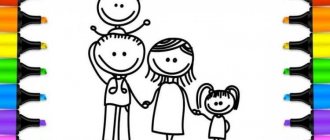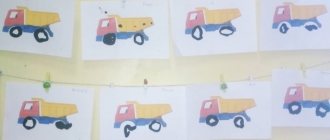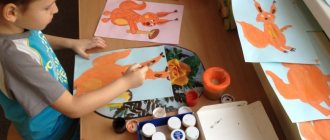Notes on drawing “Ripe, red, pouring apple” for children of the younger group
Svetlana Melnikova
Notes on drawing “Ripe, red, liquid apple” with children of the younger group
1. Teach children to paint an apple with gouache paints ;
2. Develop aesthetic perception, the ability to convey the characteristic features of an artistic image;
3. Cultivate artistic taste.
1. Didactic games: “Fruits and vegetables”, “Wonderful bag”, “Guess the description;
2. Reading the fairy tale by Vladimir Suteev “The Bag of Apples ”.
Materials: gouache paints , brushes, palette, jars of water, napkins, album sheets.
1. Poster "Fruits";
2. Image of an apple ;
Notes on drawing in the junior group "Apples"
Yulia Skorik
Notes on drawing in the junior group "Apples"
Goal: Continue to teach the child to hold a brush correctly in his hand; draw small circles; Place the circles evenly on the tree branches.
Strengthen the ability to correctly paint a circle.
Develop an interest in drawing.
Material: red and yellow paints; tassels; a glass for water; napkins; dummy apple;display board; a sheet of drawing paper with a drawing blank: outline of a tree.
Methods and techniques: playful, surprise moment, visual, literary word, verbal story, explanation, conversation, questions, practical part, individual work, summing up.
Progress of the lesson
Children sit on chairs in a semicircle.
Educator: Guys, look, I have a bag in my hands. Are you wondering what's in it? It will open only if you guess the riddle:
It grows on a branch.
Adults love him
Children's answer: Apple
Educator: Now I’ll open the bag and see if you guessed correctly.
(I open the bag and take out an apple)
Educator: Guys, what is this?
Children's answer: Apple!
Educator: Well done! You guessed the riddle correctly! Let's see what color it is?
Children's answer: Red
Children's answer: Yellow
Educator: Correct! Apples, guys, are fruits. They are very tasty. They are sweet and sour, juicy, aromatic. Guys, where do apples grow?
Children's answer: on a tree
Educator: What is this tree called?
Children's answer: apple tree
(I show the children a sample)
Educator: Look, the apples are round, big and small. Some are hanging above, on the branches, and some have fallen - lying below, on the ground.
Oh, there are no apples on this apple tree. Let's draw them?
See how to do it:
I dip the brush into the red paint with all its bristles, wipe off the excess paint on the edge of the jar and start drawing circles: the big one will be a big apple, and the small one will be a small apple. Now we draw a yellow apple, but first, we need to wash the brush and wipe it on a napkin. I pick up some paint and paint yellow apples. Did you like my apples?
Educator: Come in, sit down at the tables. I will give you leaves with apple trees and you can draw your own apples on them.
Take the brushes in your hands. You need to hold the brush with three fingers: the thumb and middle one hold the brush, and the index finger is on top.
Show how you all know how to hold a brush correctly.
Let's draw our apples in the air, big and small, above and below.
Now you can start your work.
(Independent activity of children. Individual work with children. Review of children's work. Analysis of work performance. Encouragement)
Educator: Well done guys! How beautiful the apple trees turned out! And what kind of apples grew on them: red, yellow!
The apple is ripe, red, sweet,
The apple is tasty, with a smooth skin.
I'll break the apple in half
I'll share an apple with my friend. (Ya. Akim)
Now we will put our trees on the window to dry. Let the sun look at them and admire them.
Our lesson is over. All the guys completed the task. Well done!
Notes on drawing in the first junior group "Tree" Notes on artistic and aesthetic development (drawing) On the topic: "Tree" age group 1st junior Educational objectives:.
Notes on drawing in the second junior group "Droplets" Notes on drawing in the second junior group "Droplets" Goal: to develop children's interest in finger painting. Develop the ability to lower.
GCD summary for drawing in the second junior group “Funny Matryoshkas” GCD summary for drawing in the second junior group “Funny Matryoshkas”. Goal: To develop attention, logical thinking, observation.
Notes on drawing in the first junior group “The Road to the Bunny” Note on drawing in the first junior group “ROAD TO THE BUNNY” Integration of educational areas: artistic and aesthetic.
Notes on drawing in the second junior group “Ladybug” Topic: “Ladybug” Educational areas: “Cognitive development”, “Speech development”, “Artistic and aesthetic”, “Socially.
Notes on drawing in the second junior group “Winter Tree” Objectives: to consolidate children’s knowledge about what changes happen to trees in winter; expand children's understanding of the natural phenomenon of snowfall;
Abstract of the educational activity for drawing in the younger mixed-age group “Trolley” Topic: “Trolley” (based on the nursery rhyme “A squirrel is sitting on a cart”) Objectives: To introduce children to the Russian folk nursery rhyme “A squirrel is sitting on a cart”, to help.
Lesson notes for the second junior group “Apples for Mishka” Lesson notes for the second junior group. Developed by the teacher of the second junior group, Evgeniya Yuryevna Krugova. Theme: “Apples for Mishka.”
GCD for artistic and aesthetic development in the first junior group (drawing) “Apples for a hedgehog” Objectives: To develop a plot and play concept in children, to arouse interest in the image, to encourage them to draw round shapes, to choose a color as desired.
Source
Progress of the lesson:
Educator: (starts story)
It grew in the garden on a
red-sided , pouring , warmed by the sun.
What fruit do you think I'm talking about now? Children: About the apple (if the children find it difficult to answer, the teacher helps)
.
Educator: Guys, listen, someone is snorting behind the door.
(The teacher opens the door)
.
The group includes a hedgehog .
Hedgehog: Hello children.
Children: Hello hedgehog.
Hedgehog: I came to you with the gifts of autumn, with gifts. (Places dummies of apples )
. What do you guys think, what is this?
Children: Apples
Hedgehog: That's right, these are apples
Educator: Well done. Guys, now look at the apples that the hedgehog brought. what shape are they?
Educator: How do ripe apples differ from unripe ones?
Children: ripe apples are sweet , not ripe apples are sour
Educator: And now I propose to go to your workplace and draw a red , juicy, ripe apple .
(The teacher shows the sequence of work)
1. Paint an apple with red paint
2. Paint one barrel with yellow paint , one stroke
3. Next, we draw a stick with brown paint , with the help of which the apple is held on the branch and pleases with its aroma and color.
Educator: Guys, but before you start your work, you need to stretch your fingers.
The hedgehog stomped along the path (bend your fingers one by one)
He carried apples in a basket (first on his left hand, then on his right)
To count apples ,
You need to bend your fingers (at the end of the exercise, your hands should be
clenched in fists)
Educator: Now, you can get to work, guys.
(The children do the work, and the hedgehog helps them)
Educator: Guys, put your brushes aside, it’s time to rest.
That's an apple !
full of ripe juice .
Stretch out your hands and pick an apple .
The wind began to shake the twig,
It's hard to get an apple .
I’ll jump up, reach out my hand and quickly pick an apple .
(After physical education, the children continue to work)
Educator: Guys, what beautiful apples you turned out in your drawings. I want to read the poem:
Svetochka is very happy,
Apple on a branch!
The apple tree is swaying,
Eat an apple!
And the apple laughs -
It’s not given into your hands!
Hedgehog: Children, let's play the game "Wonderful bag." This bag contains fruits and vegetables,” you must determine by touch that it is a fruit or a vegetable (children play a didactic game with the Hedgehog)
.
After playing, the Hedgehog says goodbye to the children .
Hedgehog: Goodbye guys.
Preview:
Summary of GCD for drawing in the first junior group
"Apples for guests."
Objectives: To create conditions for familiarization with the non-traditional technique of drawing apple stamps: freely place stamps on the surface of the sheet.
1. Educational: Introduce an unconventional drawing technique - stamp, consolidate knowledge of color and shape. Activate the vocabulary of familiar words, enrich the vocabulary: fruits
2. Developmental: Develop imaginative and logical thinking, children's creative abilities, visual and auditory attention, ability to answer questions, develop fine motor skills.
3. Educational: To cultivate perseverance, responsiveness, a friendly attitude towards others, a desire to help the doll.
Equipment: Doll Alenka, halves of apples, red gouache paints, plastic plates for paint and apples, white paper circles (plates), a picture with an apple, a separate table with dolls sitting at it, oilcloths for the tables, napkins.
Preliminary work: Conversation about health: “I love vitamins”, conversations on the topic “What do apples grow on?” (on which tree). Looking at pictures of “Fruits”. Games with sand - learn how to make imprints of round shapes (round mold) on wet sand.
Methods and techniques: verbal, visual, practical. Surprise moment, showing, explanation, questions, talking together, showing how to draw, showing a sample, individual work, encouragement.
Activation of vocabulary, apples, round shape, red color, fruit.
Progress of continuous educational activities.
Org. Moment: There is a knock on the door.
Educator: Guys, look who came to us. This is the Alenka doll, let's say hello to her: Hello, Alenka!
V.: Alenka, beautiful, look how rosy her cheeks are. This is because Alenka loves to eat fruit.
Guys, now I’ll tell you a riddle, and you’ll find out which fruit Alenka likes to eat the most.
I'm growing on a branch.
Adults love me
And little children.
V.: That's right guys! But to be healthy, Alenka not only eats fruit, but she also does exercises. Let's do some exercises too.
Finger gymnastics “Apple tree”
There is an apple tree by the road (arms clasped above head, fingers unclenched)
An apple hangs on a branch. (put your wrists together)
I shook the branch vigorously (arms above my head, moving back and forth)
Here we have an apple. (palms in front of the chest, imitate holding an apple)
V.: Guys, Alenka told me that she was expecting her friends to visit. Her friends also love apples, so Alenka came to ask us to draw apples for her guests. Let's sit down at the tables. (Children go to the tables). I have an apple already drawn on my plate. What color is the apple?
D.: Red. (individual answers).
V.: Correct. Let's say together - The apple is red. (answer in unison). What shape is an apple?
V.: Yes, the apple is round in shape. (Child's name), what shape is an apple? (individual answers). Let's say together - The apple is round in shape. (answer in unison). Now I'll show you how to draw it. I take the stamp, dip it in paint and apply it to the plate. Look what kind of apple I got. Now try to draw such an apple.
Children begin work during which actions and rules are spelled out, and assistance is provided if necessary.
V.: Alenka, look what beautiful apples the guys made! (general positive assessment of children’s work).
V.: Guys, while you and I were drawing, guests came to Alenka, let's take our apples to them. (Children give drawings to guests - dolls).
V.: Guys who came to visit (Alenka doll). What did we draw today? (apple). For whom did we draw apples? (for girlfriends of Alenka doll).
Source
Direct educational activities in the younger group: speech development and drawing
Summary of direct educational activities in the first junior group of kindergarten.
Author : Elena Pavlovna Cheshkova, teacher at the Child Development Center of the Municipal Budgetary Educational Institution No. 59 “Chickens”. Description: This material will be useful to kindergarten teachers working with younger preschoolers. Summary of direct educational activities - speech development and drawing: “Apples for Masha’s doll.” Goal: Continue to develop speech and fine motor skills. Program content: Speech development: Form a culture of communication (say hello to the doll Masha), consolidate words (black-browed, thin, curved, blond, blue, pink). Help children answer questions: Who is this? What apple did I cook today? What color are apples? Teach individually to pronounce the vowel sound A. Social and communicative development : Evoke in children an emotional response and a desire to participate in a gaming situation. Cognitive development : Introduce T. Gostyukhina’s new poem “They gave me a doll.” Expand children's knowledge about actions with a doll: walking, doing exercises, putting in a crib, teaching order. The children rock it and sing the song. Developmental tasks : Develop fine motor skills by teaching how to draw round objects. Exercise children in the ability to hold a pencil correctly. Develop sensory knowledge: color, shape, size. Preliminary work : Games with dolls: give tea, put them to bed, ride in strollers, feed, take a walk, etc. Materials for the lesson : Doll in clothes, A-4 album sheets, flat dolls according to the number of children (cut out of thick paper and covered with colored paper), glue stick, colored pencils (red, yellow, green), apple, saucer.
Progress of direct educational activities
A doll comes into the group: “Hello, children!”
The teacher turns to the children: “Guys, look, someone has come to us. Who is this? (encourages children to answer: “doll”)
Teacher: “That’s right, it’s a doll, and her name is Masha.”
Reading of T. Gostyukhina’s poem “They gave me a doll”
They gave me a doll for my birthday. It's just a miracle, joy and luck. I threw away my toys, I just play with her, I forget about everything in the world with Masha. I also feed my dear friend, I put Masha on the pillow to sleep. We walk with the doll, do exercises, together we get used to order with Mashenka. I take care of the doll, I cherish it. With her I became better, I became kinder...
Teacher: “Look how cute my doll Masha is! Black-browed - black eyebrows, thin, curved (show), blue eyes, pink lips, light blond hair. She is wearing a red skirt and a spotted jacket with fur trim (all words are accompanied by a show). Masha is dressed warmly: in brown pants and boots, and on her head is a blue cap. Masha really loves it when I swing her in my arms, like this (show) and sing “A-A-A!”
Savely, shake the doll Masha, sing her song: “A-A-A.”
Veronica, please rock the Masha doll. Sing your favorite song (I encourage you to sing A-A-A). Dima will also rock the Masha doll and sing a song to her.
Seryozha, rock the Masha doll. And my doll Masha really loves apples. Look what apple I prepared for her today (show)?
It is yellow, round, large (explanation with demonstration).
We invite each child to pick up an apple and examine it. Teacher: “The doll Masha wants to tell me something (brings the doll to her ear). It turns out that the doll Masha has girlfriends (showing flat dolls) and they also love apples.
Guys, can you draw apples for the dolls? What color are apples? (showing green, yellow, red pencils).
Choose a pencil and sit down at the table.
We accompany the children’s actions with the words: “there is a pencil on the middle finger, the index finger is on top of the pencil, and the thumb is held on the side.
The teacher shows how to draw apples in a circular motion. Independent activity of children.
After finishing drawing, we glue the flat dolls onto children's sheets. At the end of the lesson, the teacher, on behalf of the doll Masha, thanks the children for the drawn apples.
Doll Masha and her friends say goodbye to the kids and go to the older group to show the children's work to other preschoolers.
We recommend watching:
GCD summary for junior group 2. Journey to the spring forest GCD summary in the 2nd junior group with a presentation on the topic: Bee GCD on artistic creativity (modeling) in the 2nd junior group GCD summary in the 2nd junior group on the topic: Family
Similar articles:
Summary of lessons in kindergarten in the 2nd junior group. Doctor's profession
Summary of a lesson on social and communicative development in the junior group of kindergarten
Lesson notes about kindergarten. Junior group





